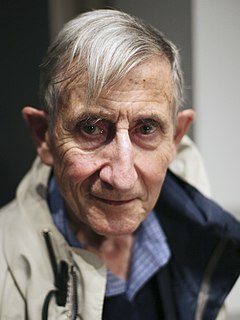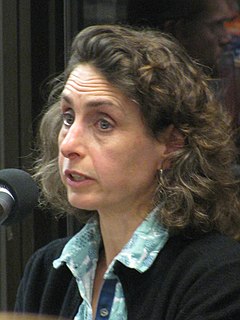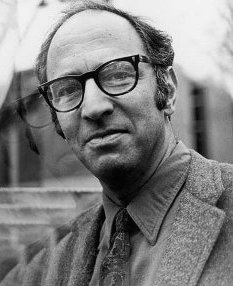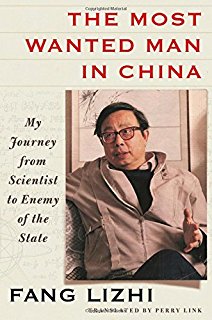
Freeman John Dyson was an English-American theoretical physicist and mathematician known for his works in quantum field theory, astrophysics, random matrices, mathematical formulation of quantum mechanics, condensed matter physics, nuclear physics, and engineering. He was Professor Emeritus in the Institute for Advanced Study in Princeton and a member of the Board of Sponsors of the Bulletin of the Atomic Scientists.

Richard Phillips Feynman was an American theoretical physicist, known for his work in the path integral formulation of quantum mechanics, the theory of quantum electrodynamics, the physics of the superfluidity of supercooled liquid helium, as well as his work in particle physics for which he proposed the parton model. For contributions to the development of quantum electrodynamics, Feynman received the Nobel Prize in Physics in 1965 jointly with Julian Schwinger and Shin'ichirō Tomonaga.

Lynn Margulis was an American evolutionary biologist, and was the primary modern proponent for the significance of symbiosis in evolution. Historian Jan Sapp has said that "Lynn Margulis's name is as synonymous with symbiosis as Charles Darwin's is with evolution." In particular, Margulis transformed and fundamentally framed current understanding of the evolution of cells with nuclei – an event Ernst Mayr called "perhaps the most important and dramatic event in the history of life" – by proposing it to have been the result of symbiotic mergers of bacteria. Margulis was also the co-developer of the Gaia hypothesis with the British chemist James Lovelock, proposing that the Earth functions as a single self-regulating system, and was the principal defender and promulgator of the five kingdom classification of Robert Whittaker.

James Gleick is an American author and historian of science whose work has chronicled the cultural impact of modern technology. Recognized for his writing about complex subjects through the techniques of narrative nonfiction, he has been called "one of the great science writers of all time". He is part of the inspiration for Jurassic Park character Ian Malcolm.

Infinite In All Directions (1988) is a book on a wide range of subjects, including history, philosophy, research, technology, the origin of life and eschatology, by theoretical physicist Freeman Dyson. The book is based on the author's Gifford Lectures delivered in Aberdeen in 1985. Infinite in All Directions can roughly be summarized as a treatise on the universe and humanity's role and its responsibilities.
The lectures were given in two series, and this book is accordingly divided into two parts. Part 1 is about life as a scientific phenomenon, about our efforts to understand the nature of life and its place in the universe. Part 2 is about ethics and politics, about the local problems introduced by our species into the existence of life on this planet.
Freeman Dyson is Professor of Physics at Princeton’s Institute for Advanced Study. That is a title, not a recommendation. What recommends him is his ability to communicate, not merely the interest of science and its application to human activities of every kind, but the sheer delight he takes in the universe. He loves diversity. Frequently throughout the book a passage will reveal his pleasure at being alive and seeing and thinking. He has much of Richard Feynman’s enthusiasm for the strangeness of people and things.
The Lewis Thomas Prize for Writing about Science, named for its first recipient, Lewis Thomas, is an annual literary prize awarded by The Rockefeller University to scientists or physicians deemed to have accomplished a significant literary achievement; it recognizes "scientists as poets." Originally called the Lewis Thomas Prize for the Scientist as Poet, the award was first given in 1993. Recipients' writings bridge the gap between the laboratory and the wider world, in the spirit of Lewis Thomas' collection of essays The Lives of a Cell.

Breaking the Spell: Religion as a Natural Phenomenon is a 2006 book by American philosopher and cognitive scientist Daniel Dennett, in which the author argues that religion is in need of scientific analysis so that its nature and future may be better understood. The "spell" that requires "breaking" is not religious belief itself but the belief that it is off-limits to or beyond scientific inquiry.

Seed is a defunct online science magazine published by Seed Media Group. The magazine looked at big ideas in science, important issues at the intersection of science and society, and the people driving global science culture. Seed was founded in Montreal by Adam Bly and the magazine was then headquartered in New York with bureaus around the world. May/June 2009 was the last print issue. Content continued to be published on the website until its demise in 2012.

Margaret Wertheim is an Australian-born science writer, curator, and artist based in the United States. She is the author of books on the cultural history of physics, and has written about science, including for the New York Times, Los Angeles Times, Guardian, Aeon and Cabinet. Wertheim and her twin sister, Christine Wertheim, are co-founders of the Institute For Figuring (IFF), a Los Angeles-based non-profit organization though which they create projects at the intersection of art, science and mathematics. Their IFF projects include their Crochet Coral Reef, which has been shown at the 2019 Venice Biennale, Hayward Gallery (London), Museum of Arts and Design (NYC), and the Smithsonian's National Museum of Natural History. For her work with public science engagement, Wertheim won the 2016 Klopsteg Memorial Award from the American Association of Physics Teachers and Australia's Scientia Medal (2017).

Elizabeth Kolbert is an American journalist, author, and visiting fellow at Williams College. She is best known for her Pulitzer Prize-winning book The Sixth Extinction: An Unnatural History, and as an observer and commentator on the environment for The New Yorker magazine. The Sixth Extinction was a New York Times bestseller and won the Los Angeles Times’ book prize for science and technology. Her book Under a White Sky was one of the Washington Post’s ten best books of the 2021. Kolbert is a two-time National Magazine Award winner, and was awarded the BBVA Biophilia Award for Environmental Communication in 2022. Her work has appeared in The Best American Science and Nature Writing and The Best American Essays.

Chaos: Making a New Science is a debut non-fiction book by James Gleick that initially introduced the principles and early development of the chaos theory to the public. It was a finalist for the National Book Award and the Pulitzer Prize in 1987, and was shortlisted for the Science Book Prize in 1989. The book was published on October 29, 1987 by Viking Books.
New York Review Books (NYRB) is the publishing division of The New York Review of Books. Its imprints are New York Review Books Classics, New York Review Books Collections, The New York Review Children's Collection, New York Review Comics, New York Review Books Poets, and NYRB Lit.

The Oxford Book of Modern Science Writing is an anthology of scientific writings, arranged and introduced by Richard Dawkins of the University of Oxford. Published first in March 2008, it contains 83 writings on many topics from a diverse variety of authors, which range in length from one to eight pages. All inclusions are dated post-1900, and include poetry, anecdotes, and general philosophical musings.

Thomas Samuel Kuhn was an American philosopher of science whose 1962 book The Structure of Scientific Revolutions was influential in both academic and popular circles, introducing the term paradigm shift, which has since become an English-language idiom.
Engineering on an astronomical scale, or astronomical engineering, i.e., engineering involving operations with whole astronomical objects, is a known theme in science fiction, as well as a matter of recent scientific research and exploratory engineering.

The Information: A History, a Theory, a Flood is a book by science history writer James Gleick, published in March 2011, which covers the genesis of the current information age. It was on The New York Times best-seller list for three weeks following its debut.
Jeremy Bernstein is an American theoretical physicist and science essayist.

The Most Wanted Man in China: My Journey from Scientist to Enemy of the State is the autobiography of the Chinese astrophysicist and activist Fang Lizhi. Fang narrates his experiences from youth through his 1989 request for asylum at the U.S. embassy in Beijing.
From Eros to Gaia is a non-fiction scientific book of 35 non-technical writings by Freeman J. Dyson, Professor Emeritus of Physics at Princeton's Institute for Advanced Study. This book is a collection of essays written from 1933 to 1990. It was originally published by Pantheon Books in 1992.

Uncertainty: the Life and Science of Werner Heisenberg is a biography by David C. Cassidy documenting the life and science of Werner Heisenberg, one of the founders of quantum mechanics. The book was published in 1992 by W. H. Freeman and Company while an updated and popularized version was published in 2009 under the title Beyond Uncertainty: Heisenberg, Quantum Physics, and The Bomb. The book is named after the quantum mechanics concept known as Heisenberg's uncertainty principle. It has been reviewed many times and was generally well received.















